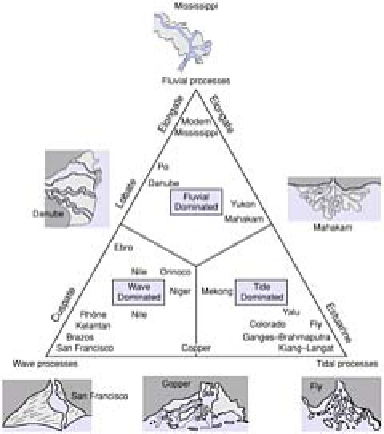Environmental Engineering Reference
In-Depth Information
coast, where tides, waves and the necessary large fluvial sediment flux all help to shape
the delta landsystem (Figure 17.7).
The delta front advances by sediment deposition as bed- and suspended-load particles
enter lower-velocity water at the river mouth. Sediments enter denser (saline) water via a
plume from which they are rained out, or less dense water (where high suspended loads
raise freshwater density) via sea-bed density currents. Where river and seawater densities
are very similar, a
Gilbert-type
delta forms by successive overlap of
sediment packets
,
providing a classic bottom-set-fore-set-top-set sequence (Figure 17.8). Wave interaction
often forms transverse bars beyond the delta front. The main channel meanders, between
natural levées, through older channel and overbank sediments. A delta plain, reminiscent
of the flood plain, develops to either side. Levées are breached periodically, often in river
flood or storm conditions, and the resultant crevasse splays and distributary channels
form new delta lobes (see Chapter 14). Earth's largest modern delta (that of the Amazon)
covers 500,000 km
2
; the Ganges-Brahmaputra (Bangladesh), Mekong (Vietnam) and
Yangtze (China) each exceed 50,000 km
2
.
Figure 17.7
Classification of river deltas according to the
importance of fluvial, wave and tidal processes.
Source: After Galloway (1975).

